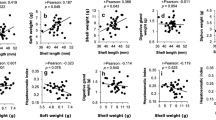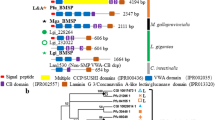Abstract
Phylum Brachiopoda evolved from the other Metazoa long before the beginning of the Cambrian and have had a long evolution way before the origin of the mineral skeleton in Early Cambrian representatives. According to their food preferences, brachiopods divided into two groups probably in Precambrian that determined the differences in digestive enzyme compositions. The increasing concentration of oxygen in sea water in the Vendian period stimulated the rates of animal radiation as well as paleogeographic and paleoecological conditions, prevaling temperatures and sea water chemistry favored the development of mineral skeletons to the beginning of the Cambrian period. The calcium phosphate and calcium carbonate shells originated in two different groups of brachiopods Linguliformea and Rhynchonelliformea respectively most likely due to the biochemical differences related to their food preferences.
Similar content being viewed by others
References
Bush, V.A., Kheraskova, T.N., and Samygin, S.G., Breakup and erly stages of evolution of the Paleoasian Ocean, Tez. dokl. na 33 Mezhd. Geol. Kongr. (Abstr. 33rd IGC Int. Geol. Congr.), Oslo, 2008.
Chen Jin-Yuan, Zhou Gui-Qing, and Ramsköld, L., The Cambrian lobopodian Microdictyon sinicum, Bull. Brit. Mus. Nat. Hist., 1995, no. 5, pp. 1–93.
Chuang Shou-hwa, The structure and function of the alimentary canal in Lingula anatine, Proc. Zool. Soc. London, 1959, vol. 132, pp. 283–311.
Chuang Shou-hwa, The larvae of a discinid (Inarticulata, Brachiopoda), Biol. Bull., 1968, vol. 135, no. 2, pp. 263–272.
Chuang Shou-hwa, Larval development in Discinisca (Inarticulata, Brachiopoda), Am. Zool., 1977, vol. 17, no. 1, pp. 39–53.
Cohen, B.L., Monophyly of brachiopods and phoronids: reconcillation of molecular evidence with Linnaean classification (the subphylum Phoroniformea nov.), Proc. R. Soc. London, B, 2000, vol. 267, pp. 225–231.
Gerasimenko, L.M. and Ushatinskaya, G.T., The experiments on fossilization: Phosphatization, in Bakterial’naya paleontologiya (Bacterial Paleontology), Rozanov, A.Yu., Ed., Moscow: Paleontol. Inst. Ross. Akad. Nauk, 2002, pp. 59–65.
Ivanova-Kazas, O.M., Evolyutsionnaya embriologiya zhivotnykh (Evolutionary Embryology of Animals), St. Petersburg: Nauka, 1995.
Jackson, D.J., Macis, L., Reitner, J., Degnan, B.M., and Worheide, G., Sponge paleogenomics reveals an ancient role for carbonic anhydrase in skeletogenesis, Science, 2007, vol. 316, no. 5833, pp. 1893–1895.
Koneva, S.P. and Ushatinskaya, G.T., New brachiopod species from the order Acrotretida from the Cambrian of central Kazakhstan, Paleontol. J., 2010, vol. 44, no. 6, pp. 632–643.
Kovalevsky, A.O., Nablyudeniya nad razvitiem Brachiopoda. Izbr. raboty (Observations on the Development of Brachiopoda. Selected Works), Moscow: 1951, pp. 267–386.
Luchinina, V.A., Korovnikov, I.V., Novozhilova, I.V., and Tokarev, D.A., Benthic Cambrian biofacies of the Siberian Platform (hyoliths, small shelly fossils, archeocyaths, trilobites, and calcareous algae), Stratigr. Geol. Correlation, 2013, vol. 21, no. 2, pp. 131–149.
Malakhov, V.V., The structure of larvae of the articulate brachiopod Cnismatocentrum sakhalinensis parvum, in Evolyutsionnaya morfologiya zhivotnykh (Evolutionary Morphology of Animals), Tr. Zool. Inst. Akad. Nauk SSSR, vol. 109, Leningrad: Nauka, 1983, pp. 147–155.
McCammon, H.M., The food of articulate brachiopods, J. Paleontol., 1968, vol. 43, no. 4, pp. 976–985.
Nielsen, C.l., The development of the brachiopod Crania (Neocrania) anomala (O.F. M üller) and its phylogenetic significance, Acta Zool. (Stockholm), 1991, vol. 72, no. 1, pp. 7–28.
Osnovy paleontologii. Mshanki. Brakhiopody (Fundamentals of Paleontology: Bryozoans, Brachiopods), Sarycheva, T.G., Ed., Moscow: Akad. Nauk SSSR, 1960.
Pan Chi-Miau and Watabe Norimitsu, Uptake and transport of shell material in Glottidia piramidata Stimpson (Brachiopoda: Inarticulata), J. Exp. Mar. Biol. Ecol., 1988, vol. 118, pp. 257–268.
Rozanov, A.Yu., Some problems in study of ancient skeletal organisms, Byull. Mosk. Ob-va lspyt. Prir., Otd. Geol., 1979, vol. 54, no. 3, pp. 62–69.
Sperling, E.A., Pisani, D., and Peterson, K.J., Molecular paleobiological insights into the origin of the brachiopoda, Evol. Dev., 2011, vol. 13, no. 3, pp. 290–303.
Treatise on Invertebrate Paleontology. Part H. Brachiopoda, Revised, vol. 1: Introduction, Kaesler, R.L., Ed., Boulder, Colo-Lawrence Kan: Geol. Soc. Am.-Univ. Kansas. Press, 1997.
Ushatinskaya, G.T., An ancient brachiopod with an organic integument from the Lower Cambrian of Mongolia, Paleontol. J., 2004, vol. 38, no. 4, pp. 358–365.
Voronova, L.G., Drozdova, N.A., Esakova, N.V., Zhegallo, E.A., Zhuravlev, A.Yu., Rozanov, A.Yu., Sayutina, T.A., and Ushatinskaya, G.T., Iskopaemye nizhnego kembriya gor Makenzi (Kanada) (Lower Cambrian Fossils of the Mackenzie Mountains, Canada), Tr. Paleontol. Inst. Akad. Nauk SSSR, vol. 224, Moscow: Nauka, 1987.
Watabe Norimitsu and Pan Chi-Miau, Phosphatic shell formation in atremate brachiopods, Am. Zool., 1984, vol. 24, no. 4, pp. 977–985.
Yatsu Naohide, On the development of Lingula anatine, J. Coll. Sci. Tokyo, 1902, vol. 17, no. 4, pp. 1–112.
Zezina, O.N., Ekologiya i rasprostranenie sovremennykh brakhiopod (Ecology and Distribution of Recent Brachiopods), Moscow: Nauka, 1976.
Zhang Zhifei, Robson, S.P., Emig, C.C., and Shu Degan, Early Cambrian radiation of brachiopods: A perspective from South China, Gondwana Res., 2008, vol. 14, pp. 241–254.
Author information
Authors and Affiliations
Corresponding author
Rights and permissions
About this article
Cite this article
Ushatinskaya, G.T. What might cause the differences in the shell composition of the earliest Brachiopods?. Paleontol. J. 48, 1502–1510 (2014). https://doi.org/10.1134/S0031030114140159
Received:
Published:
Issue Date:
DOI: https://doi.org/10.1134/S0031030114140159




